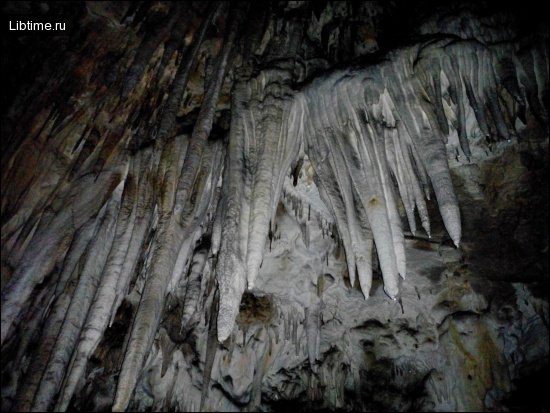Cave exploration
The underground world of caves is a realm of cold, darkness and mysterious silence. In some grottoes, especially in the northern caves, a harsh winter prevails all year round. By the light of a lantern, everything here shimmers with myriads of colorful sparks and fascinates the observer.
From a light touch on the vault delicate ice lace and crystals are scattered into the smallest dust, which for a long time swirls in the air with diamond splashes. However, in most of the caves there are no ice formations, as they retain, although low, but positive temperature throughout the year.
The walls and ceilings of the grottoes of such caves are decorated with calcite deposits. In ancient times people lived in caves. 
Especially interesting are the lakes, characterized by increased mineralization and high transparency of water. From the steel smoothness of the waters there is a cold wind. Calcite or gypsum crust of white color sometimes forms on the surface of lakes, which covers the lake like a thin ice.
If the lake level drops, a space appears between the water surface and the calcite crust. In winter time, some of the lakes near the entrance are covered with real clear and smooth ice.
The frozen waterfalls of bluish-green ice are remarkable. One might think that there is no organic life in the caves, where eternal night reigns and low temperatures prevail.
But this is not the case. Caves are home to a wide variety of animal and plant life. There are bats, some species of amphibians, various insects, spiders, millipedes, and in rivers and lakes - some species of fish and crustaceans.
In the caves of the Soviet Union now known more than 180 species of troglobionts, i.e. typical underground inhabitants.
Of plant organisms, several species of fungi are found in caves, growing on the droppings of bats, as well as rotting wooden objects. Subterranean organisms have adapted to special ecological conditions.
First of all, many of them are completely devoid of sight, but are characterized by a highly developed sense of smell. Another peculiarity is their weak pigmentation - many organisms are completely colorless.
Cave exploration is very difficult and sometimes even life-threatening. But a lot of wonderful surprises and valuable scientific discoveries await cave explorers. There are various methods of determining the age of caves.
Caves are studied by specialists from different branches of knowledge using geological, geomorphological, topographical, geophysical, mineralogical, biospheleological, paleontological, archaeological and other methods.
At present, the study of caves began to apply special techniques, which greatly expanded the possibility of overcoming difficult passages, chasms and siphons and allowed to penetrate into previously completely inaccessible far parts of caves, which are of special scientific interest. 
At present, there are 61 caves over 1 km long in our country, with a total length of 344,457 meters. The overwhelming majority of karst caves are small in size and represent shallow niches and tunnels located in the coastal cliffs usually at different altitudinal levels.
Large caves are less common. Among them on the territory of the former Soviet Union stands out Optimistic (Podolia) cave, the length of which reaches 92,000 meters.
Of particular interest are vertical caves or mines. The largest natural mine in the former USSR is the Snezhnaya Cave (Caucasus) with a depth of 770 meters.
Caves are not eternal
Caves do not exist forever. Under certain conditions they originate, develop and then collapse, being filled with clay material, concretions and stone blocks that have fallen from the vaults.
The process of filling of underground cavities goes in parallel with their formation. However, in the initial period it is less energetic than the process of rock destruction, so the underground cavities gradually increase.
As the caves develop, accumulation processes are activated, and underground cavities, filled with various materials, may disappear altogether.
The study of underground karst cavities is of great scientific interest and has an important applied value.
It provides valuable material for a comprehensive study of the complex and contradictory karst process, allows to identify the main regularities and features of karst, without taking into account which in areas where easily soluble carbonate and sulfate rocks are distributed, no economic activity can be carried out, since the impact of karst is manifested in a variety of spheres of human activity.


